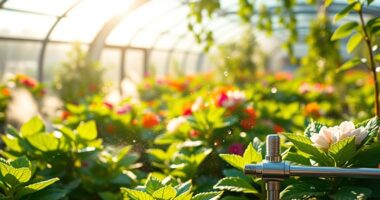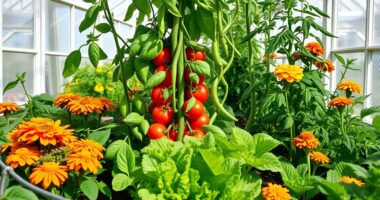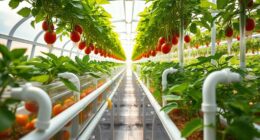To grow strawberries in a greenhouse, start by selecting the right variety, like Seascape for year-round fruiting. Prepare well-draining, loamy soil with a pH of 5.5 to 7.0 and use containers with drainage holes. Manage temperatures between 20-24°C during the day and ensure adequate lighting with at least six hours of sunlight or equivalent artificial light daily. Use drip irrigation for watering and maintain humidity levels between 60-75%. There’s more to learn on how to maximize your strawberry harvest!
Key Takeaways
- Choose the right strawberry variety based on your desired harvest schedule, such as ever-bearing or June-bearing types.
- Prepare well-draining, loamy soil with a pH between 5.5 and 7.0, and use containers with proper drainage.
- Maintain optimal temperatures, targeting 20-24°C (68-75°F) during the day and 10-12°C (50-54°F) at night.
- Ensure plants receive at least six hours of direct sunlight or equivalent artificial light daily for optimal growth.
- Implement drip irrigation for consistent watering and maintain humidity levels between 60-75% RH to promote healthy plants.
Variety Selection for Greenhouse Strawberries

When selecting strawberry varieties for your greenhouse, it’s essential to consider the different characteristics that suit your growing conditions and preferences.
Ever-bearing varieties, like Seascape, produce fruit throughout the season, while June-bearing types, such as Albion, offer a large crop in early summer.
If you’re looking for consistent production, day-neutral varieties like Evie-2 are a great option.
For cooler temperatures or shaded areas, Alpine varieties thrive with less care.
You might also explore perpetual fruiting types, which start cropping in late autumn.
Popular choices also include San Andreas for vertical gardening and Quinault for reliable sweetness.
Always factor in disease resistance and yield potential to ensure a fruitful harvest.
Preparing Soil and Containers
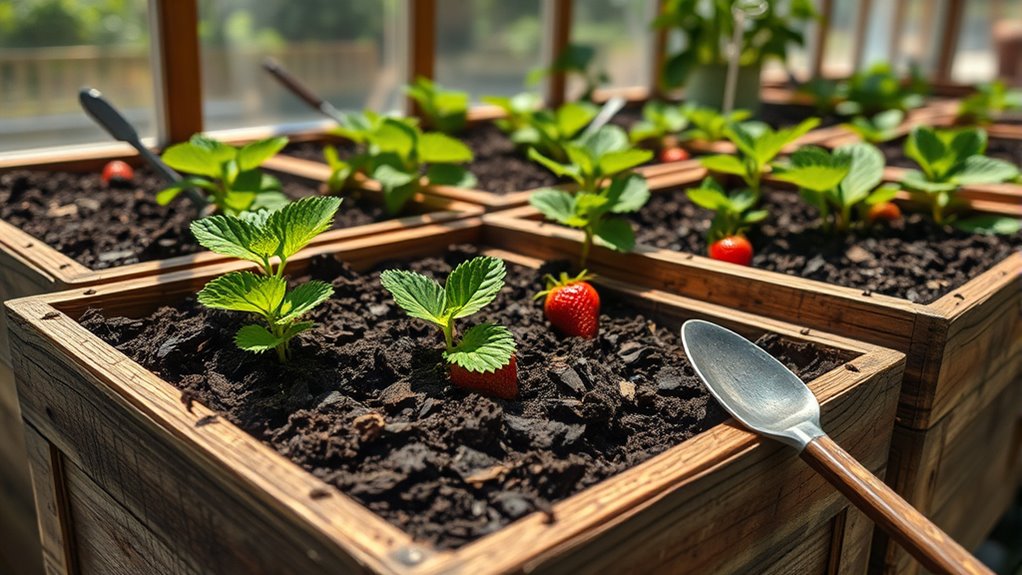
To successfully grow strawberries in your greenhouse, you need to prepare the soil and select appropriate containers carefully.
Start with well-draining, loamy soil enriched with organic compost, maintaining a pH between 5.5 and 7.0. Mix in plenty of organic matter to boost fertility and apply a water-soluble organic compost rich in potash.
When it comes to containers, choose pots at least six inches in diameter and 12-15 inches deep, ensuring they’ve adequate drainage holes. Consider using hanging baskets for space-saving vertical options.
Space plants about 18 inches apart, keeping the crown just above the soil. After planting, water thoroughly and maintain consistent moisture without waterlogging to support healthy growth.
Managing Temperature for Optimal Growth
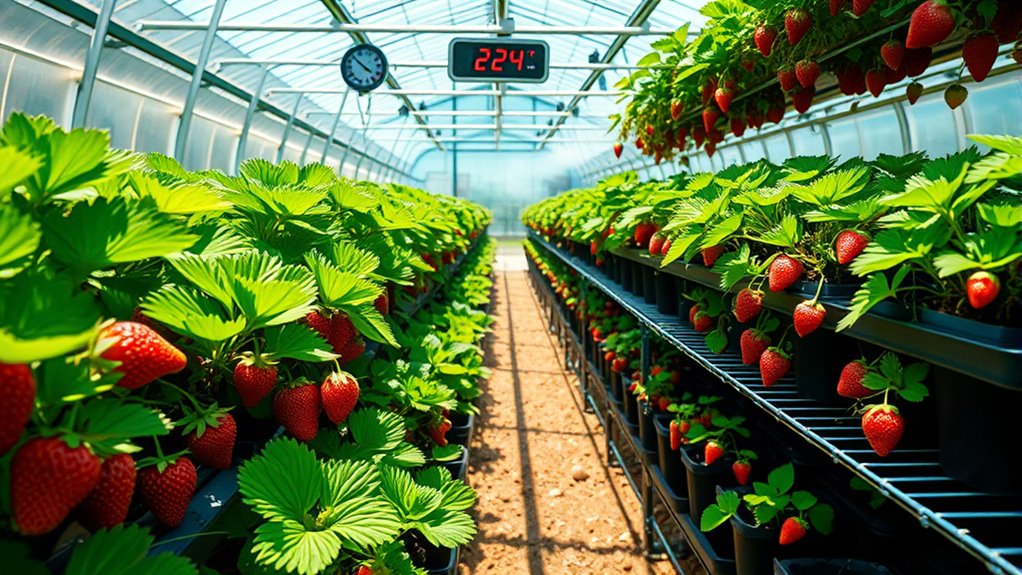
Managing temperature in your greenhouse is crucial for achieving optimal strawberry growth, as both extreme heat and cold can hinder development. Aim for daytime temperatures between 20-24°C (68-75°F) and nighttime temperatures around 10-12°C (50-54°F).
During the flowering stage, keep temperatures between 16-20°C (60-68°F) for best results. Once your strawberries start to fruit, lower the temperature to 15-16°C (59-61°F) for proper maturation.
Maintain temperatures between 16-20°C during flowering, then reduce to 15-16°C for optimal strawberry maturation.
Use heating pipes, HVAC systems, and wet pads to maintain these conditions. Ensure good ventilation and consider shade systems to prevent overheating.
Regularly monitor temperatures, and automate adjustments when possible to create a stable environment for your strawberries, avoiding fluctuations that can stunt growth and reduce yields.
Providing Adequate Lighting Conditions

Providing adequate lighting conditions is essential for healthy strawberry growth in your greenhouse, as insufficient light can stunt development and reduce yields. Aim for at least six hours of direct sunlight or equivalent artificial light daily.
For optimal yields, target a Daily Light Integral (DLI) of 15-25 mol/m²/day. Ever-bearing strawberries thrive with 14-16 hours of light, while June-bearing varieties prefer fewer than 13 hours.
Use full-spectrum LED grow lights, positioned about 12 inches above your plants, to mimic natural sunlight. Automated timers ensure consistent lighting schedules, allowing your strawberries to rest at night.
Watering Techniques and Humidity Control
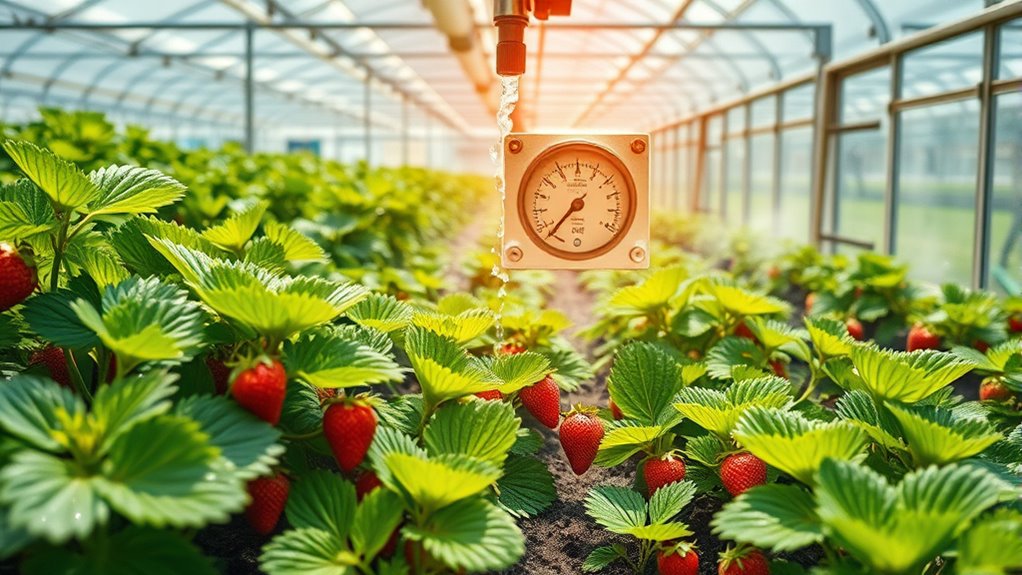
Effective watering techniques and humidity control are vital for growing healthy strawberries in a greenhouse.
Using drip irrigation delivers water directly to the roots, reducing waste and disease risks. Aim for frequent small waterings, about 33 mL per plant at a time, with total daily amounts usually between 200 to 400 mL.
Maintain a drainage percentage of 30-40% to prevent saturation. For humidity, keep levels between 60-75% RH and a Vapor Pressure Deficit (VPD) of 0.3-1.2 kPa.
Use ventilation methods like screens and vents to help control humidity, as high levels can slow nutrient uptake and foster diseases. This balance is essential for optimal growth and minimizing pesticide use.
Understanding Pollination Needs
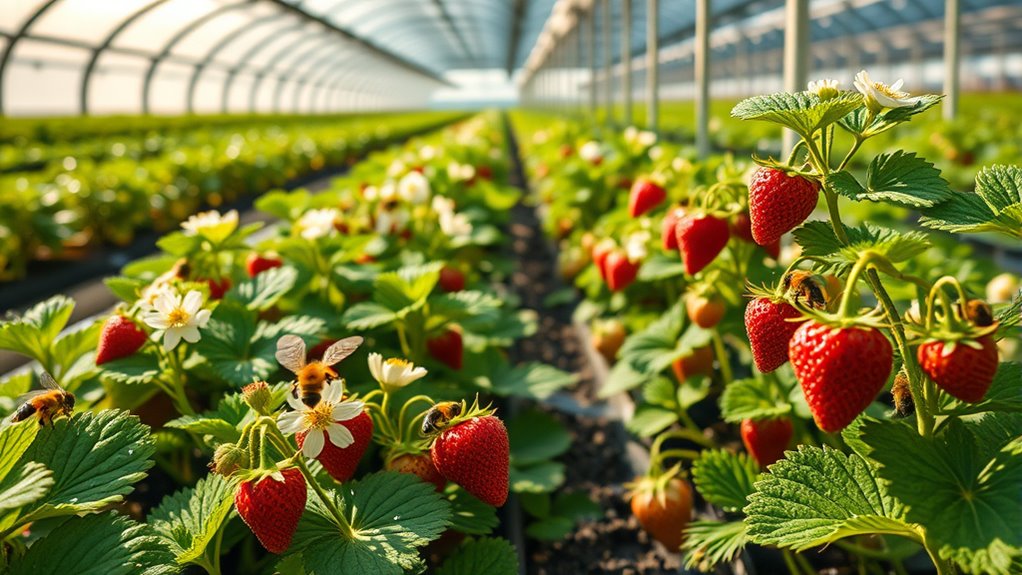
How can you ensure your strawberries thrive and produce delicious fruit? Understanding pollination needs is key.
Strawberry flowers require pollination for proper fruit development; without it, you might end up with misshapen berries. While strawberries are self-fertile, utilizing insect pollinators like honeybees and bumblebees can significantly boost your yields.
In a greenhouse, maintain optimal temperatures between 16°C and 20°C and ensure good airflow to facilitate pollen transfer. You might also consider electric pollinators for added support in small setups.
Planting different cultivars together encourages cross-pollination, enhancing fruit quality and yield. By paying attention to these aspects, you’ll set the stage for a bountiful strawberry harvest.
Implementing Pest Management Strategies
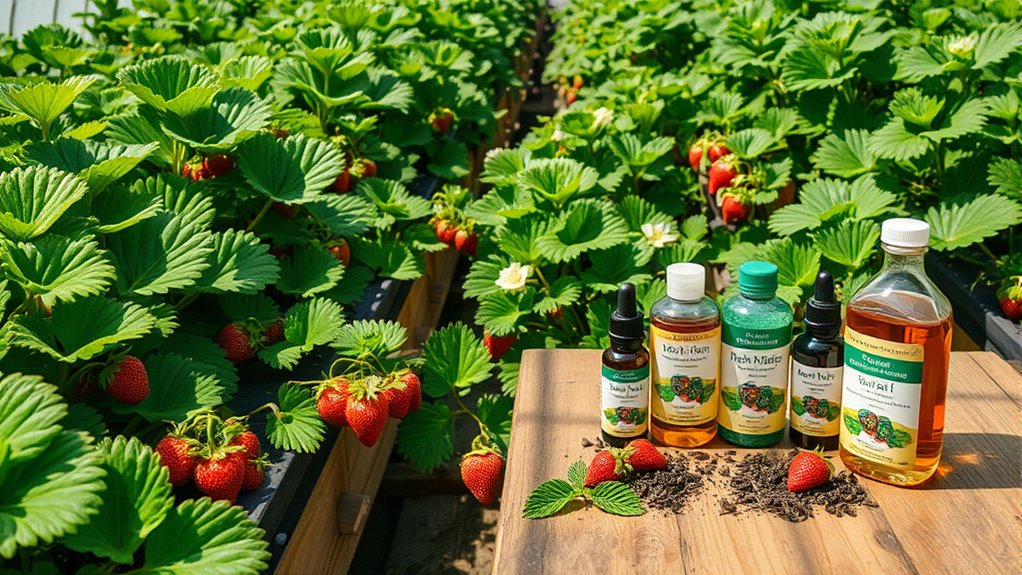
While growing strawberries in a greenhouse offers many advantages, it also presents unique challenges, particularly when it comes to managing pests.
You’ll likely encounter twospotted spider mites, thrips, aphids, and whiteflies, all of which can harm your plants. To prevent infestations, install insect screens on air intakes and ensure all openings are properly sealed.
Regularly scout your plants for signs of pests, using yellow sticky traps to monitor aphid populations. Consider natural enemies like aphid parasitoids and green lacewing larvae for biological control.
When necessary, you can use miticides or organic treatments like neem oil, but be cautious to protect beneficial insects.
Combining these strategies will help you maintain a healthy strawberry crop.
Fertilization Practices for Healthy Plants
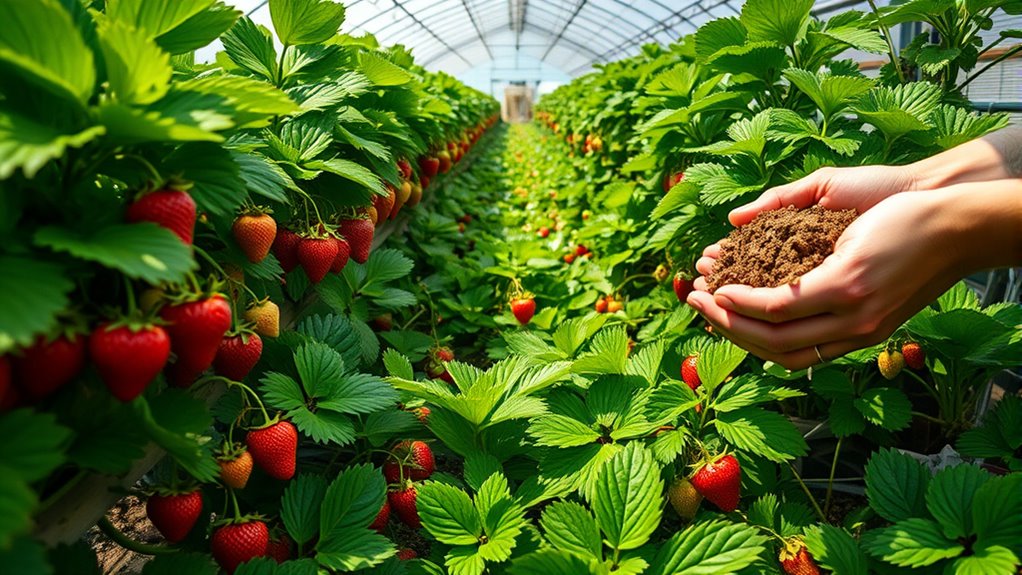
To ensure your strawberry plants thrive in a greenhouse environment, understanding their fertilization needs is crucial. Start by incorporating well-aged compost into the soil, as it provides essential nutrients and supports beneficial fungi.
Choose between organic and chemical fertilizers based on your preferences and scale. Apply fertilizers early in the growing season and consider additional foliar feedings for micronutrients.
Maintain soil pH between 5.5 and 7.0 for optimal growth. If you’re using hydroponics, adopt precision fertilization techniques like drip irrigation to deliver nutrients directly to the roots.
Regular soil testing helps you monitor nutrient levels and adjust your fertilization strategy accordingly, ensuring your plants receive a balanced nutrient supply without the risk of over-fertilization.
Best Practices for Harvesting Strawberries

Harvesting strawberries at the right time is essential for maximizing flavor and yield. Aim to pick them when they’re fully colored and ripe, typically 30-45 days post-flowering.
During peak season, harvest every other day to prevent rot and enhance taste. Mornings are the best time to pick, as strawberries are sweetest then. Avoid wet conditions to reduce spoilage, and ensure your greenhouse is well-ventilated.
Use clean tools to minimize disease spread and handle the berries gently to avoid bruising. For variety-specific strategies, remember that June-bearing strawberries need one concentrated harvest, while everbearing and day-neutral types allow for continuous picking.
After harvesting, trim runners and maintain a cool environment to support future growth.
Frequently Asked Questions
How Long Does It Take for Strawberries to Fruit After Planting?
After planting strawberries, the time it takes to fruit varies based on the type.
If you’re using bare root plants, you can expect fruit in about 3 months. However, if you’re starting from seeds, it could take up to 150 days.
Once the flowers appear, you’ll typically wait another 3 to 4 weeks for the fruit to be ready for harvest.
Can Strawberries Be Grown Hydroponically in a Greenhouse?
Absolutely, you can grow strawberries hydroponically in a greenhouse!
Imagine a lush oasis where strawberries flourish, dancing in nutrient-rich water. By utilizing hydroponics, you’ll maximize space and boost yields while keeping pests at bay.
Embrace year-round production and enjoy the sweet taste of fresh strawberries, regardless of the season. Just ensure you monitor temperature and humidity to keep your strawberries thriving in their controlled paradise.
It’s a fruitful endeavor waiting for you!
What Are Common Diseases Affecting Greenhouse Strawberries?
Common diseases affecting strawberries include Botrytis (grey mold), which causes decay, and powdery mildew, presenting as a white coating on leaves.
You might also encounter leaf spots from various pathogens, leading to necrotic patches.
Bacterial issues like crown rot and fruit rot can also arise.
Oomycete diseases, such as downy mildew and root rot, threaten plant health.
To combat these, focus on disease-free plants, proper sanitation, and resistant varieties.
How Often Should I Check for Pests in the Greenhouse?
Oh, you think checking for pests is a once-a-month hobby? Think again!
You need to inspect your greenhouse regularly, especially during peak pest seasons. Aim for at least once a week, unless you enjoy uninvited guests like aphids and spider mites.
Use yellow sticky traps to catch the sneaky ones, and keep records of your findings. It’s like a pest detective story, minus the popcorn but with plenty of drama!
What Tools Are Essential for Greenhouse Strawberry Cultivation?
For successful strawberry cultivation in a greenhouse, you’ll need several essential tools.
First, invest in strawberry transplanters for efficient planting.
Pruning tools like handheld pruners help maintain plant health, while harvesting tools, such as hullers and picking trays, ensure gentle fruit collection.
Additionally, soil preparation tools and fertilization equipment are crucial for maintaining optimal soil conditions and nutrient levels.
With these tools, you’ll promote healthy growth and a bountiful harvest.
Conclusion
As you pluck those plump, ruby-red strawberries from their lush green leaves, you’ll savor the sweet rewards of your greenhouse efforts. With careful attention to variety, soil, and light, you’ve nurtured a vibrant oasis bursting with life. Each juicy bite is a testament to your dedication, a taste of summer captured in your hands. Keep nurturing your plants, and soon, your greenhouse will be a treasure trove of nature’s candy, ready to delight you and your loved ones.


